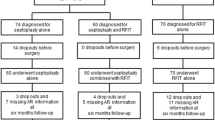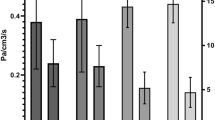Abstract
The objective of the study was to evaluate the outcome of septoplasty without inferior turbinectomy in patients with septum deviation and nasal obstruction. After exclusion of allergic rhinitis, this study included 30 patients with deviated nasal septum and hypertrophied inferior nasal turbinate who were prepared for septoplasty without turbinectomy. After full history taking and complete otorhinological examination, all patients graded their extent of obstruction using the Nasal Obstruction Symptoms Evaluation scale and underwent CT scans to evaluate the side and shape of deviation, thickness of the medial and lateral mucosa and inferior conchal bone on both the concave and convex sides. Postoperative (PO) follow-up consisted of evaluation of surgical outcome, nasal obstruction grading and patient’s satisfaction. CT imaging was repeated for evaluation of the previous items and to compare with preoperative data. All surgeries were conducted smoothly without intraoperative complications and all were managed as day surgery. The mean duration of follow-up was 20.1 ± 4.4 months. All patients showed progressive significant decline of nasal obstruction symptoms and only eight patients still had mild symptoms. Patients’ satisfaction scores showed significant progressive increase reaching a peak at the 12th month. Preoperative CT confirmed the presence of hypertrophied mucosa on the concave septal side with significantly thicker medial and non-significantly thicker lateral mucosa on the concave side compared to the convex side. At the 12th month PO, mean medial mucosal thickness significantly decreased on the concave side with significant increase on the convex side, but the effect was significantly pronounced on the concave side. Mean lateral mucosal thickness was significantly decreased on the concave and non-significantly increased on the convex side. Conchal bone thickness showed non-significant change despite the diminution on both sides In the absence of allergic rhinitis, septoplasty without turbinectomy significantly improves nasal obstruction-related manifestations and approaches high patient satisfaction with associated reduction of hypertrophied mucosa and spares turbinectomy-related complications.






Similar content being viewed by others
References
Rozsasi A, Leiacker R, Knemann S, Lindemann J, Kappe T, Rettinger G, Keck T (2007) The impact of septorhinoplasty and anterior turbinoplasty on nasal conditioning. Am J Rhinol 21(3):302–306
Lee HY, Kim CH, Kim JY, Kim JK, Song MH, Yang HJ, Kim KS, Chung IH, Lee JG, Yoon JH (2006) Surgical anatomy of the middle turbinate. Clin Anat 19(6):493–496
Farmer SE, Eccles R (2006) Chronic inferior turbinate enlargement and the implications for surgical intervention. Rhinology. 44(4):234–238
Mlynski G (2006) Surgery of the nasal septum. Facial Plast Surg 22(4):223–229
Miles BA, Petrisor D, Kao H, Finn RA, Throckmorton GS (2007) Anatomical variation of the nasal septum: analysis of 57 cadaver specimens. Otolaryngol Head Neck Surg 136(3):362–368
Stewart MG, Witsell DL, Smith TL, Weaver EM, Yueh B, Hannley MT (2004) Development and validation of the Nasal Obstruction Symptom Evaluation (NOSE) scale. Otolaryngol Head Neck Surg 130(2):157–163
Van Olphen AF (1998) The Septum. Laryngoscope 108(7):1025–1032
Berger G, Hammel I, Berger R, Avraham S, Ophir D (2000) Histopathology of the inferior turbinate with compensatory hypertrophy in patients with deviated nasal septum. Laryngoscope 110(12):2100–2105
Uzun L, Savranlar A, Beder LB (2004) Enlargement of the bone component in different parts of compensatory hypertrophied inferior turbinate. Am J Rhinol. 18(6):405–410
Lindemann J, Tsakiropoulou E, Vital V, Keck T, Leiacker R, Pauls S, Wacke F, Wiesmiller KM (2009) Influence of the turbinate volumes as measured by magnetic resonance imaging on nasal air conditioning. Am J Rhinol Allergy. 23(3):250–254
Berger G, Gass S, Ophir D (2006) The histopathology of the hypertrophic inferior turbinate. Arch Otolaryngol Head Neck Surg 132(6):588–594
Gray LP (1978) Deviated nasal septum: incidence and etiology. Ann Otol Rhinol Laryngol Suppl 87(3, pt 3) (suppl 50):3–20
Eccles R (2007) Query, concerning mechanism of inferior turbinate enlargement. Arch Otolaryngol Head Neck Surg 133(6):624–625
Kim DH, Park HY, Kim HS, Kang SO, Park JS, Han NS, Kim HJ (2008) Effect of septoplasty on inferior turbinate hypertrophy. Arch Otolaryngol Head Neck Surg 134(4):419–423
Lindemann J, Keck T, Leiacker R, Dzida R, Wiesmiller K (2008) Early influence of bilateral turbinoplasty combined with septoplasty on intranasal air conditioning. Am J Rhinol. 22(5):542–545
Bandos RD (2006) Rodrigues de Mello V, Ferreira MD, Rossato M, Anselmo-Lima WT: Clinical and ultrastructural study after partial inferior turbinectomy. Braz J Otorhinolaryngol 72(5):609–616
Li HY, Lin Y, Chen NH, Lee LA, Fang TJ, Wang PC (2008) Improvement in quality of life after nasal surgery alone for patients with obstructive sleep apnea and nasal obstruction. Arch Otolaryngol Head Neck Surg 134(4):429–433
Dursun E, Battal B (2009) Clinical outcomes of nasal septal surgery at high altitude. Eur Arch Otorhinolaryngol 266(10):1579–1581
Bulcun E, Kazkayasi M, Ekici MA, Tahran FD, Ekici M (2010) Effects of septoplasty on pulmonary function tests in patients with nasal septal deviation. J Otolaryngol Head Neck Surg 39(2):196–202
Baumann I (2010) Quality of life before and after septoplasty and rhinoplasty. Laryngorhinootologie 89(Suppl 1):S35–S45
Author information
Authors and Affiliations
Corresponding author
Rights and permissions
About this article
Cite this article
Haroon, Y., Saleh, H.A. & Abou-Issa, A.H. Nasal soft tissue obstruction improvement after septoplasty without turbinectomy. Eur Arch Otorhinolaryngol 270, 2649–2655 (2013). https://doi.org/10.1007/s00405-012-2304-0
Received:
Accepted:
Published:
Issue Date:
DOI: https://doi.org/10.1007/s00405-012-2304-0




